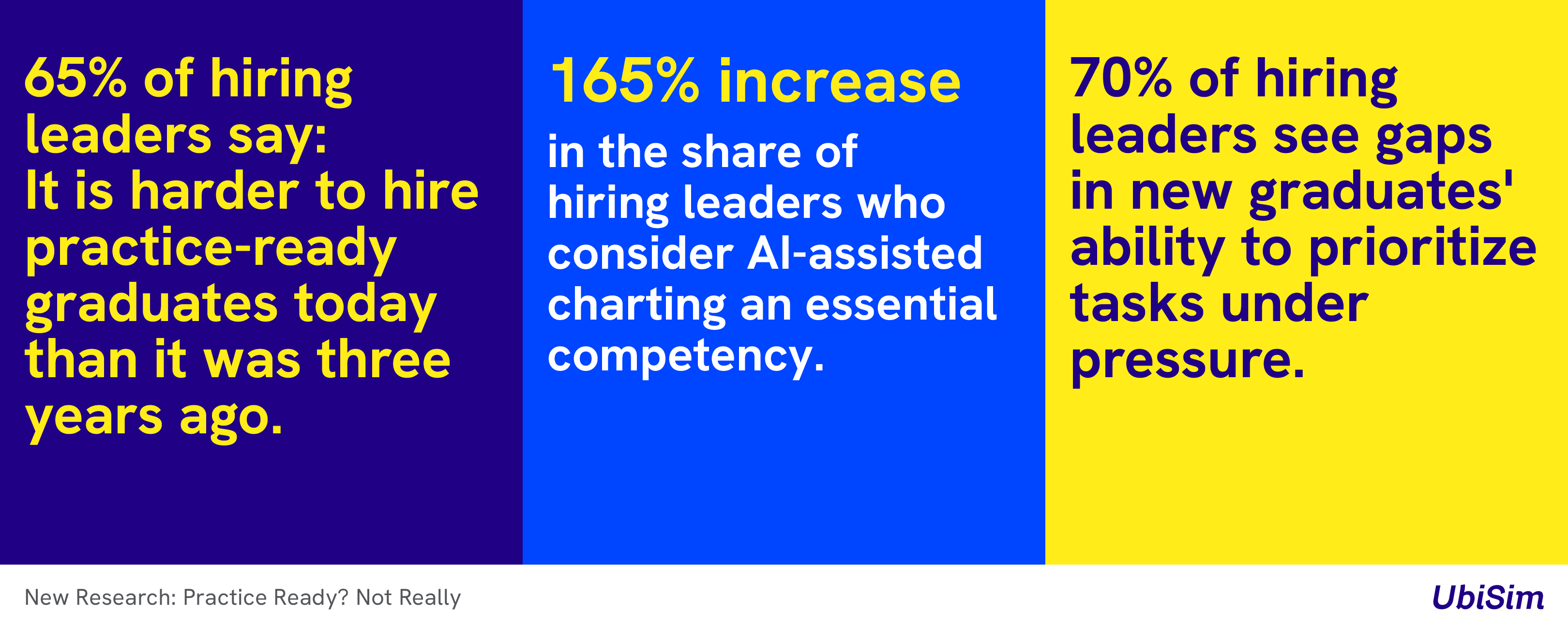2025 Research: The Widening Gap Between Nursing Education and What Hospitals Actually Need

Table of Contents
Name of the heading
Across healthcare systems, newly graduated nurses today are entering a workplace transformed by emerging tools, persistent staffing shortages, and rising patient acuity. This 2025 research, based on a survey of 390 hospital and health-system hiring leaders across the United States and Canada, reveals how quickly employer expectations are evolving—and how far most nursing programs must go to keep pace.
Walk through any hospital ward and you can feel the tension. Staffing shortages mean heavier patient loads; rising acuity means each case carries higher stakes. For hiring managers, the challenge isn't just filling open roles—it's finding nurses who can thrive on day one.

The Hiring Reality: Understanding the Gap
Hiring managers draw clear distinctions between novice and veteran nurses, and the differences they highlight go beyond first-day jitters. The research identifies where new graduates struggle most compared to experienced RNs across multiple critical competencies, from clinical judgment in high-pressure scenarios to patient communication and modern technology workflows.
Expectations have evolved faster than most nursing programs have been able to keep pace. Only 17% of hiring leaders say today's programs fully prepare graduates for current hospital needs.
AI Skills: No Longer Optional
Perhaps the most dramatic shift revealed in the data: familiarity with AI-assisted charting has moved from a "nice-to-have" to an essential competency for the majority of hiring managers, representing a 165% increase in just three years.
But despite concerns about automation, those staffing hospitals aren't worried about nurses being replaced. The research shows that hospital leaders view AI as a tool that raises the bar for human expertise rather than eliminates the need for it.
The full report includes detailed data on which AI tools hospitals are adopting, how different experience levels compare on technology competencies, and which healthcare roles are actually at risk from automation.
What "Day-One Ready" Really Means
For today's hospital leaders, a "day-one ready" nurse is more than a walking textbook. Yet nearly two-thirds of hiring leaders agree that most new graduates excel at textbook knowledge but struggle to apply it in unpredictable patient scenarios.
The research reveals the complete hierarchy of competencies that define practice-ready nurses—and how those expectations vary significantly by hospital type, with Magnet-designated facilities setting an even higher bar in specific areas.
Closing the Gap: Where to Go From Here
The challenge also represents an unprecedented opportunity. The research explores innovative training models, partnership structures between hospitals and nursing schools, and the specific investments healthcare employers are willing to make to develop the next generation of nurses.
The question isn't whether the gap can be closed—it's which strategies deliver the best outcomes and how to implement them effectively.
Download the Complete Research Report
This overview highlights key trends, but the full report provides the actionable data and frameworks nursing educators and hospital administrators need to close the gap.
Inside the full report:
- Complete competency gap analysis and rankings: Detailed data on where new graduates struggle most versus experienced nurses, broken down by hospital type, region, and specialty, plus the full hierarchy of "day-one ready" competencies
- Partnership models and funding mechanisms: Ranked list of collaboration opportunities hospital leaders will invest in, including specific funding commitments, implementation frameworks, and step-by-step strategies for securing employer support
- Technology training roadmap and implementation playbook: Which AI and clinical technologies hospitals are adopting, what training new nurses actually need, and evidence-based strategies for curriculum transformation including simulation and experiential learning metrics
The survey was conducted between July 31st and August 15th, 2025, with 390 full-time hospital and healthcare system employees in North America who are directly involved in hiring new nurses. The study was conducted at 95% confidence with a ±5% margin of error.




